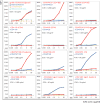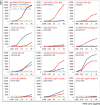HIV-1 ENVELOPE. Effect of the cytoplasmic domain on antigenic characteristics of HIV-1 envelope glycoprotein
- PMID: 26113642
- PMCID: PMC4701381
- DOI: 10.1126/science.aaa9804
HIV-1 ENVELOPE. Effect of the cytoplasmic domain on antigenic characteristics of HIV-1 envelope glycoprotein
Abstract
A major goal for HIV-1 vaccine development is the production of an immunogen to mimic native, functional HIV-1 envelope trimeric spikes (Env) on the virion surface. We lack a reliable description of a native, functional trimer, however, because of inherent instability and heterogeneity in most preparations. We describe here two conformationally homogeneous Envs derived from difficult-to-neutralize primary isolates. All their non-neutralizing epitopes are fully concealed and independent of their proteolytic processing. Most broadly neutralizing antibodies (bnAbs) recognize these native trimers. Truncation of their cytoplasmic tail has little effect on membrane fusion, but it diminishes binding to trimer-specific bnAbs while exposing non-neutralizing epitopes. These results yield a more accurate antigenic picture than hitherto possible of a genuinely untriggered and functional HIV-1 Env; they can guide effective vaccine development.
Copyright © 2015, American Association for the Advancement of Science.
Figures




Comment in
-
HIV. The modern era of HIV-1 vaccine development.Science. 2015 Jul 10;349(6244):139-40. doi: 10.1126/science.aac7800. Science. 2015. PMID: 26160931 No abstract available.
References
Publication types
MeSH terms
Substances
Grants and funding
LinkOut - more resources
Full Text Sources
Other Literature Sources

